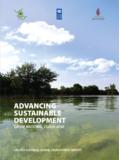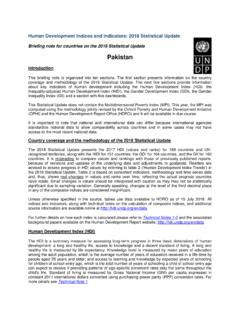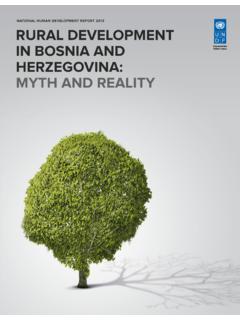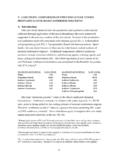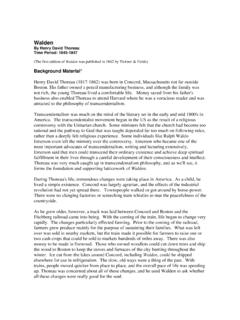Transcription of 1. ENERGY AND HUMAN WELL-BEING
1 1. ENERGY AND HUMAN WELL-BEING HUMAN WELL-BEING is a difficult concept to quantify. Many attempts have been made in that direction the most obvious of them being the use of gross domestic product (GDP) per capita as an indicator. The shortcomings of such approach are well known and for this reason the HDI ( HUMAN Development Index) has been conceived as a composite of longevity measured by life expectancy knowledge measured by a combination of adult literacy (two-thirds weight) and mean years of schooling (one-third weight); and standard of living measured by purchasing power, based on real GDP per capita adjusted for the local cost of living (purchasing power parity PPP). A rough idea of the relevance of ENERGY to well being can be gained by plotting HDI as a function of per capita (commercial + non-commercial) ENERGY consumption per year for a large number of countries, as shown in Figure 1.
2 It is apparent from this figure that, for an ENERGY consumption above 1 ton of oil equivalent (toe)/capita per year, the value of HDI is higher than and essentially constant for all countries. One toe/capita/year seems, therefore, the minimum ENERGY needed to guarantee an acceptable level of living as measured by the HDI, despite many variations of consumption patterns and lifestyles across countries. The statistical analysis presented above shows clearly that ENERGY has a determinant influence on the HDI, particularly in the early stages of development in which are presently 1 toe/year = Figure 1 HDI versus annual primary ENERGY consumption (commercial + non-commercial per capita.)
3 The vast majority of the world s people, particularly women and children. It also shows that the influence of per capita ENERGY consumption on the HDI begins to decline somewhere between 1 and 3 toe per inhabitant. Thereafter, even with a tripling in ENERGY consumption, the HDI does not increase. Thus, from approximately 1 toe per capita, the strong positive covariance of ENERGY consumption with HDI starts to diminish. Additional increases in HDI are more closely correlated to the other variables chosen to define it (life expectancy, educational level, and per capita income). A serious problem with such analysis resides on the fact that commercial and non-commercial ENERGY consumption are related in a complex way to the ENERGY services that ENERGY offers, which in households include illumination, cooked food, comfortable indoor temperatures, refrigeration and transportation.
4 ENERGY services are also required for virtually every commercial and industrial activity. For instance, heating and cooling are needed for many industrial processes, motive power is needed for agriculture and electricity is needed for telecommunications and electronics. The ENERGY chain that delivers theses services begin with the collection or extraction of primary ENERGY , that in one or several steps, maybe converted into ENERGY carriers, such as electricity or diesel oil, that are suitable for end uses. ENERGY end-use equipment stoves, light bulbs, vehicles, machinery converts final ENERGY into useful ENERGY , which provides the desired benefits the ENERGY services. An example of an ENERGY chain beginning with coal extraction from a mine (primary ENERGY ) and ending with produced steel as an ENERGY service is shown in figure 2.
5 ENERGY services are the result of a combination of various technologies, infrastructure (capital), labor (know-how) materials and primary ENERGY . Each of these inputs carries a price tag and they are partly substitutable for one another. From the Figure 2. An example of the ENERGY chain, from primary ENERGY to services consumer s perspective, the important issues are the economic value or utility derived from the services. Consumers are often unaware of the upstream activities required to produce ENERGY services. Despite these caveats, the value of 1 toe/capita/year of primary ENERGY consumption as an indicator of well being can be obtained less empirically using the Latin American World Model proposed by the Bariloche Foundation several decades ago.
6 The Bariloche study explores possible physical limits to establishing a society in which basic HUMAN needs are satisfied and, on the basis of a simple econometric model, investigates the possibility of doing so with current economic resources. The target levels assumed in the Latin American World Model are: 3000 kcal and 100 grams of protein per person per day; one house (50 square meters of living area) per family; and 12 years of basic education ( , school enrolment of all children between 6 and 17 years). The quantitative definition of a representative package of basic HUMAN needs is difficult for various reasons. For one, basic needs vary with climate, culture region, period in time, age and sex. For another, there is not a single level of basic needs but a hierarchy.
7 There are needs, such as a minimum of food, shelter and protection from fatal diseases, that have to be met for survival. Satisfaction of higher-level needs such as basic education make productive survival possible. Top-level needs such as travel and leisure arise when people try to improve their quality of life beyond productive survival. Obviously, needs perceived as basic vary according to living conditions in any given society. Despite the difficulties involved in defining and ranking HUMAN needs, the three quantitative measures considered in the Latin American World Model may be regarded as a basic core for productive survival. The final result of the Latin American World Model is the GNP per capita needed to satisfy basic HUMAN needs: this monetary income has been converted to commercial ENERGY units using appropriate elasticity coefficients for the sectors considered.
8 Thus the amount of commercial ENERGY needed to satisfy basic HUMAN needs is obtained. It is well known, however, that a large number of people in rural areas in developing countries do not have access to commercial ENERGY due to lack of purchasing power or other reasons. These people depend for survival on non-commercial ENERGY sources, principally firewood, dung and agricultural wastes, which they gather at a negligible monetary cost. In many developing countries, non-commercial ENERGY accounts for a significant proportion of total primary ENERGY consumption and x 103 kcal/day per capita is considered to be a representative figure. Adding this number to the cost of commercial ENERGY to meet basic needs yields the total ENERGY cost of satisfying basic HUMAN needs which, as shown in table , ranges between x 103 and x 103 kcal/day per capita, , between and toe/capita.
9 Table I - Basic needs: per capita ENERGY consumption Region Year Commercial ENERGY (kcal/day) Non-commercial ENERGY (kcal/day) Total ENERGY (kcal/day) Latin America 1992 x 103 x 103 x 103 Africa 2008 x 103 x 103 x 103 Asia 2020 x 103 x 103 x 103 Source: Krugman, H and Goldemberg, J. The ENERGY Cost of Satisfying Basic HUMAN Needs Technological Forecasting and Social Change, 24, 45-60 (1983).
10 Basic HUMAN needs might be met by a primary ENERGY amount of approximately 1 toe/capita/year, but it is obvious that the idea of well being goes beyond that. One very interesting study has tried to approach the problem starting from the assumption that the standard of living of the Western Europe, Japan, Australia and New Zealand in the mid 1970s could be considered satisfactory and the immense population living in developing countries would be very well off it had access to the services be available to the people of the above mentioned countries. The activity levels in these countries in the mid 1970s are given in Appendix I and are basically the following: a renewable solid house with 25 m2 per capita; water supplies and sanitation; clean easy-to-use cooking fuel (gas, for example); electrical lighting.


